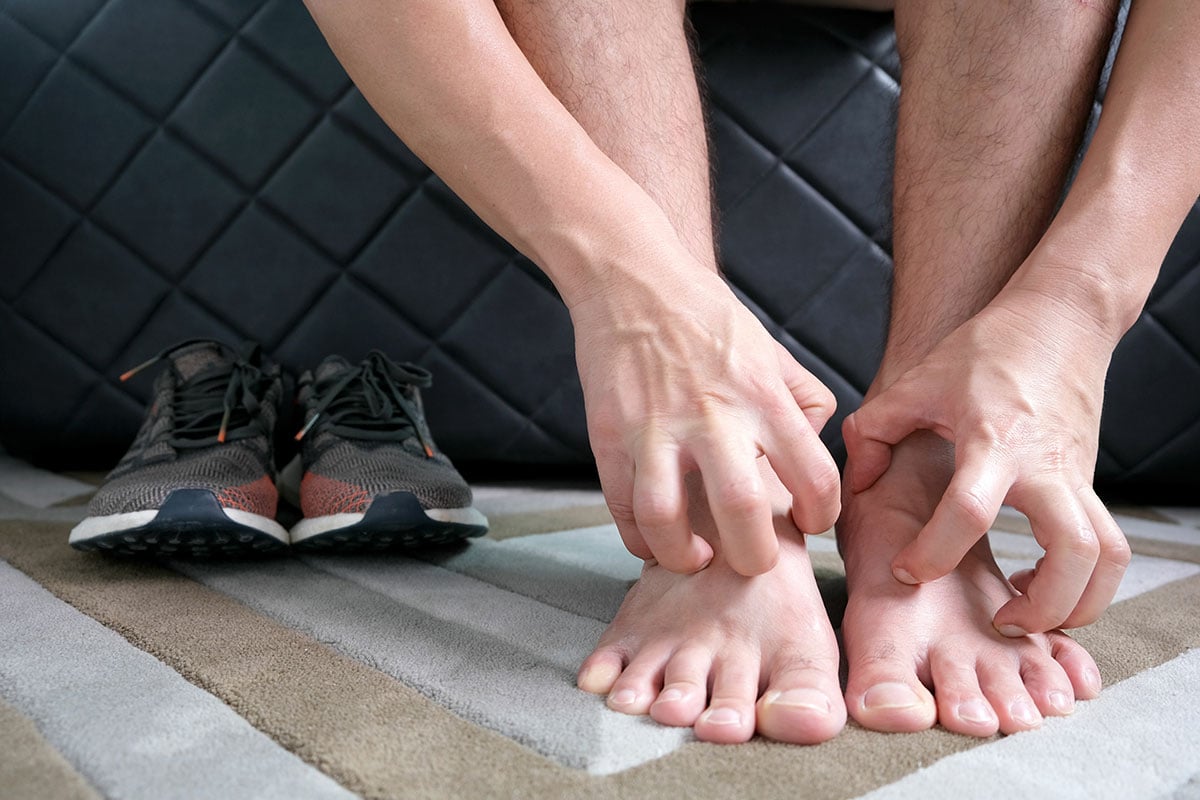Athlete’s foot, or tinea pedis, is a very common fungal skin infection of the skin that affects the web spaces between the toes and soles of the feet. Fungal infections can be contagious as they are passed from one person to the next, especially in public areas where people go barefoot. This infection is commonly spread on contaminated floors of public spaces such as locker rooms, swimming pools, or nail salons. This infection is commonly spread on contaminated floors of public spaces such as gyms, swimming pools, or nail salons.
What are the symptoms of athlete’s foot?
Patients will often present with:
- itching and burning of the feet.
- red, scaly or peeling skin
- blistering
Some patients may not notice anything wrong with their feet and think it is just “dry skin”.
How is athlete’s foot diagnosed?
Podiatrists are often able to diagnose athlete’s foot infection simply by looking at it.
A skin lesion biopsy may be performed to rule out other conditions, such as psoriasis, dermatitis, or a low-grade skin infection. Your podiatrist will scrape off a small piece of the infected skin and place it in a potassium hydroxide (KOH) solution. The KOH dissolves normal skin cells so that only fungal cells are visible.
What are risk factors for developing fungal infection?
There are many possible causes of skin irritation of the foot that may not necessarily be caused by a fungus. Allergic reactions from a foreign material (contact dermatitis), eczema, and psoriasis are all differential diagnoses to athlete’s foot.
People with a low immune system will typically be more at risk for developing a fungal infection. This includes people with diabetes, HIV/AIDS, and cancer, who have more trouble fighting foreign pathogens in their bodies.
How to preventing athlete’s foot
Most cases of athlete’s foot can be avoided by wearing waterproof shoes or flip-flops when walking around in locker rooms, public showers, and public pool areas.
Because fungi thrive in a moist environment, it’s important to keep your feet dry and:
- thoroughly drying your feet with a towel after having a shower or bath or after swimming
- wear shoes that aren’t too tight and let your feet breathe
- wear socks made from material that draws moisture away from the feet, such as cotton, silk, or wool.
- not wearing the same pair of shoes two days in a row
- taking your shoes off as often as possible
- wear shoes that are well-ventilated and made of natural materials
- Applying talcum powder or antifungal powder to your feet to absorb moisture.
Athlete’s foot treatment
Treatment for athlete’s foot includes topical medication to help stop the fungus from replicating and growing on your foot. There are many different fungal medications on the market, including over the counter (OTC) medications and prescription medications. These products contain clotrimazole, miconazole, tolnaftate or terbinafine.
Antifungal medications are available as tablets, powders, liquids, gels, sprays and creams. After applying medication to the affected area, it is important to wash hands thoroughly with soap and warm water to avoid spreading to other parts of the body.
More severe cases that are resistant to antifungal creams may require an oral pill to rid the fungus. These pills contain fluconazole, itraconazole or terbinafine.
Athlete’s foot FAQs
Can athlete’s foot spread?
Yes, athlete’s foot can spread to other parts of the body, often by touching the infected area and then touching another body part, such as the hands or groin, and it can also spread to other people through direct contact or by walking barefoot in contaminated areas like locker rooms or showers.
Will athlete’s foot go away on its own?
Athlete’s foot may not always go away on its own without treatment. In some cases, mild forms can resolve over time with good foot hygiene, but more often, treatment with antifungal medications is necessary to fully clear the infection. Without proper treatment, the infection can persist and even spread to other parts of the body or other people.
What will happen if athlete’s foot goes untreated?
If athlete’s foot goes untreated, the infection can worsen, leading to more severe itching, burning, and discomfort. The skin may crack, blister, or peel, increasing the risk of a secondary bacterial infection. Additionally, the fungus can spread to other parts of the body, including nails, hands, and groin, and potentially to other people. Untreated athlete’s foot can result in persistent and potentially painful symptoms, emphasizing the importance of early and effective treatment.
Is athlete’s foot a fungus?
Yes, athlete’s foot is a foot fungus, specifically caused by fungi in the dermatophytes group. It thrives in warm, moist environments, affecting the skin on the feet.
To Sum it Up
Athlete’s foot is a very common skin infection that is readily treatable.
Athlete’s foot is the most common form of tinea infections. The fungi that cause athlete’s foot belong to a group which also cause jock itch and ringworm. If not treated, the skin may crack, opening up the possibility of a bacterial infection or onychomycosis. The skin infection may also spread to the toenails, causing a fungal nail infection which can be painful and harder to treat. If home remedies do not work, it may not be a fungus, and it is important to seek a healthcare professional for medical advice to determine what it may be.
If you have any questions regarding athlete’s foot, we encourage a consult with one of our foot and ankle specialists; (877) 877-9110 or visit us at www.footankleinstitute.com.
- Is Foot Analysis Better than Horoscopes? What Do Your Toes Reveal About Your Personality? - May 7, 2024
- The Link Between Foot Health and Posture - April 14, 2024
- Why Are My Feet Different Sizes? It’s More Common Than You Think - March 27, 2024
